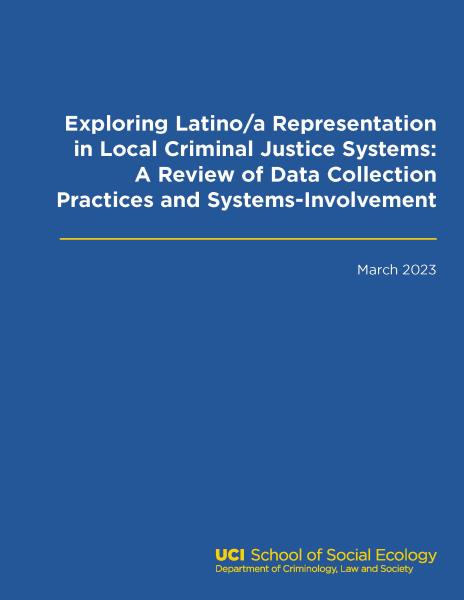
Professor Nancy Rodriguez, left, and Ph.D. candidate Rebecca Tublitz. Photo by Han Parker
Comprehensive analysis highlights Latino experience
The John D. and Catherine T. MacArthur Foundation has released a national report commissioned as part of its Safety and Justice Challenge (SJC) that highlights the experience of Latinos inside the criminal justice system. Today, just under one in five people in the U.S. self-identify as being of “Hispanic or Latino origin,” making it the second largest racial or ethnic group after White people. Despite the size and diversity of the Latino population in the U.S. — 62 million people across the U.S. identify as Latino — relatively little is known about their experiences in the criminal justice system.
 This first-of-its-kind report had previously not been undertaken due to the lack of existing data on justice-involved Latinos. While the report found that Latino and White rates of justice involvement were similar, and in many cases rates of Latinos were lower than that of Whites, these findings may be a result of the inaccurate representation of Latinos in criminal justice data. Other key findings include that Latinos made up a smaller proportion of the people arrested or booked than their countywide populations and that the inconsistent storage of data on Latinos affects systemwide understanding of racial and ethnic disparities.
This first-of-its-kind report had previously not been undertaken due to the lack of existing data on justice-involved Latinos. While the report found that Latino and White rates of justice involvement were similar, and in many cases rates of Latinos were lower than that of Whites, these findings may be a result of the inaccurate representation of Latinos in criminal justice data. Other key findings include that Latinos made up a smaller proportion of the people arrested or booked than their countywide populations and that the inconsistent storage of data on Latinos affects systemwide understanding of racial and ethnic disparities.
The full report is titled “Exploring Latino/a Representation in Local Criminal Justice Systems: A Review of Data Collection Practices and Systems-Involvement.”
“The U.S. has never paid close attention to the experience of Latino people in our criminal justice system — until now,” said Nancy Rodriguez, professor of criminology, law and society. “We hope that this report is the first of many to take a comprehensive look at this jail population, the findings from which will help us develop much-needed reforms to the system and further racial equity.”
The report was co-authored by Rodriguez, former director of the National Institute of Justice, the scientific research arm of the U.S. Department of Justice, under former President Barack Obama, and Rebecca Tublitz, a Ph.D. candidate in the School of Social Ecology’s Department of Criminology, Law and Society.
“Researchers must examine arrests and jail bookings by ethnicity and race to better understand the disparities and inequities of the criminal justice system,” said Bria Gillum, a senior program officer at MacArthur. “There’s a long road ahead when it comes to understanding the representation of Latinos in our jails and ensuring true racial and ethnic equity. With this report, we hope to contribute to the solution.”
The report is based on aggregate criminal justice data and data capacity assessment reports from 14 cities and counties that are participating the Safety and Justice Challenge; these communities are working to tackle overincarceration and inequity in their local justice system by implementing data- and community-informed solutions that can be replicated across the country. The report’s data was produced during the planning phase of the SJC initiative in 2015. The researchers also collected deidentified case-level administrative data from criminal justice agencies, including law enforcement, jail, courts, and prosecution, from four counties participating in the SJC: Charleston County, South Carolina; Harris County, Texas; Multnomah County, Oregon; and Palm Beach County, Florida.
The key findings in the report include:
Latino and Hispanic ethnicity data is inconsistently stored across local criminal justice, inhibiting system-wide understanding of racial and ethnic disparities across local jurisdictions.
Across 14 communities, just 30 percent of criminal justice record management systems capture Latino or Hispanic ethnicity data separately from racial characteristics, and the remainder capture Latino ethnicity in a single race variable, if at all.
Even where fields exist to capture ethnicity information within a database, these data are not always consistently collected for all cases passing through key criminal justice system points.
Even where agencies have the capacity to capture Latinos ethnicity, low rates of reporting and high proportions of missing data impeded accurate measurement of Latino outcomes.
At the front door to the justice system—arrest and jail booking—Latinos in four communities made up a smaller proportion of the people arrested or booked than their countywide populations.
Latino and White rates of justice involvement were similar—and in many cases rates of Latino involvement were lower than that of Whites.
Black individuals—and in particular, young Black individuals—were subject to the substantially elevated rates of arrest, jail booking, and court convictions (and dismissals), demonstrating considerable concentration of justice system contact for specifically marginalized groups.
Importantly, the researchers caution that these findings may reflect the inaccurate representation of Latinos in criminal justice data management systems across the researched communities.
Local, state, and national efforts dedicated to advancing racial equity must center the systematic recording of Latinos in the justice system.
The report demonstrates the need for ongoing research on the rates of arrests and incarcerations of Latino people. The recommendations put forth by the authors of the report include:
Standardizing the collection of race and ethnicity data across criminal justice agencies. The wide variety of procedures and practices used to collect, store, and transfer race and ethnicity information across local justice systems impedes a holistic view of how different groups experience the justice-system. The inability to measure Latino and Hispanic individuals, and in particular, to capture the diversity of experiences within the Latino community, is a key obstacle to achieving fairness and equity in the criminal justice system.
Encouraging regular examination of outcomes by race, ethnicity, and by age group. There are many ways to measure disproportionality and disparities in the criminal justice system. Given the intensification of involvement of younger populations at the front-end of the justice system — at arrest and jail — the authors recommend that jurisdictions further disaggregate by key age categories (e.g., 18-24, 25-34, etc.) within racial and ethnic groups.
Related:
Axios — Study: Jails and police rarely track Latinos' racial and ethnic data